Introduction
I didn’t always cook. For years, pasta meant boiling something in a hurry and dumping on a jar of red sauce. But somewhere between raising kids, burning dinners, and finally slowing down, I fell into Italian pasta recipes like they were old friends. The kind that don’t expect perfection. Just warmth. Simplicity. A bit of olive oil and trust. This guide isn’t about showing off. It’s about seven recipes that fit into real life busy nights, quiet Sundays, whatever. If you’ve got salt, a pot, and a bit of hunger, you’ve already got what you need. Let’s make something worth remembering.
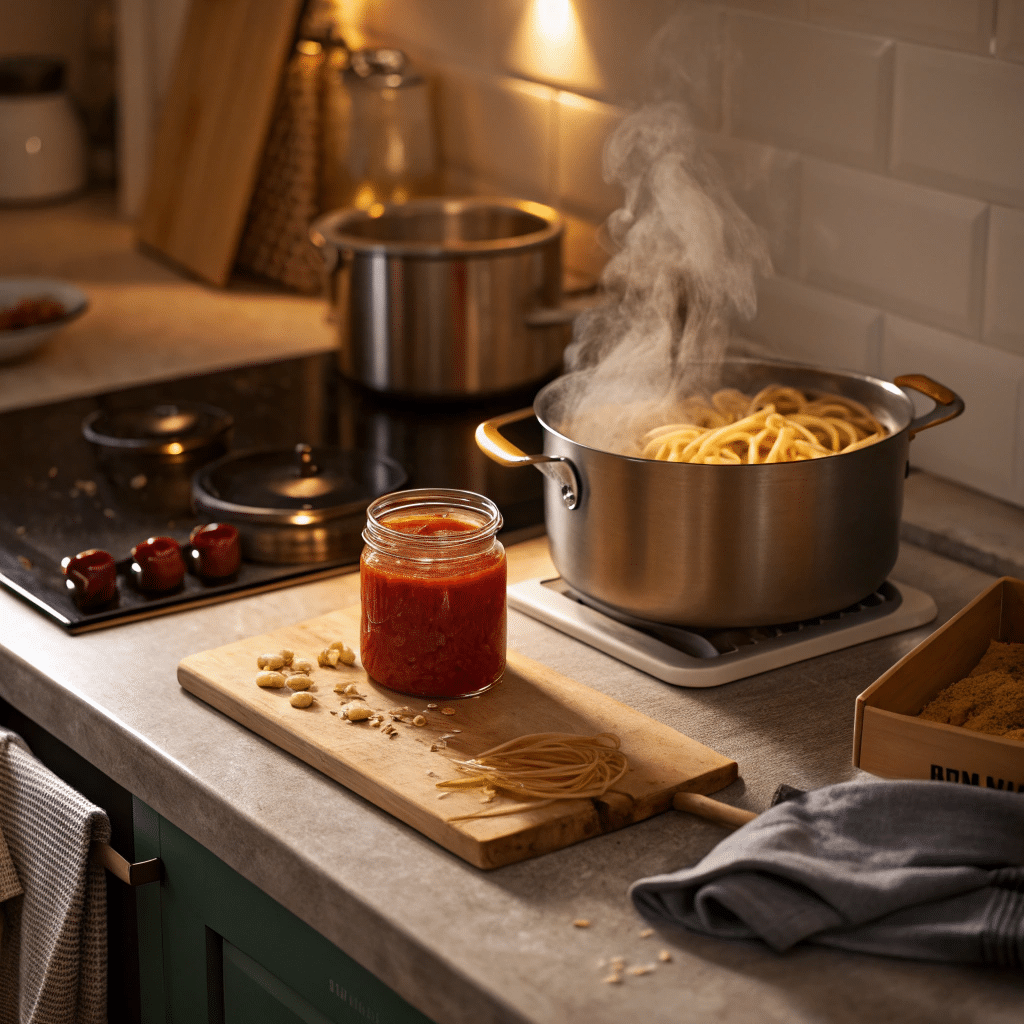
Table of Contents
Table of Contents
Why Italian Pasta Recipes Matter to Me
A kitchen full of chaos, carbs, and confidence
Hi, I’m Susan Miller. I never planned to fall for Italian pasta recipes but here I am, nearly twenty years after burning boxed spaghetti, completely in love with the real thing. I live just outside Bath with two teens, a husband who still thinks garlic is a spice, and a spaniel who thinks he’s royalty. Over the years, my kitchen turned from panic zone to pasta zone.
The first dish that changed it all? Cacio e pepe. Just pasta, cheese, pepper, and magic. One night, I nailed it. The sauce clung. The pepper cracked. And my family actually paused before speaking a rare miracle in our house. That tiny win gave me courage. I started trying more recipes, reading stories behind each one, learning not just how Italians cook pasta but why.
Italian pasta recipes are more than instructions. They’re memories. They’re slow Sundays and hungry Tuesdays. They’re what I reach for when I want to feed people I love without stress. And after plenty of floury disasters and surprise victories, I’ve found seven recipes I go back to again and again.
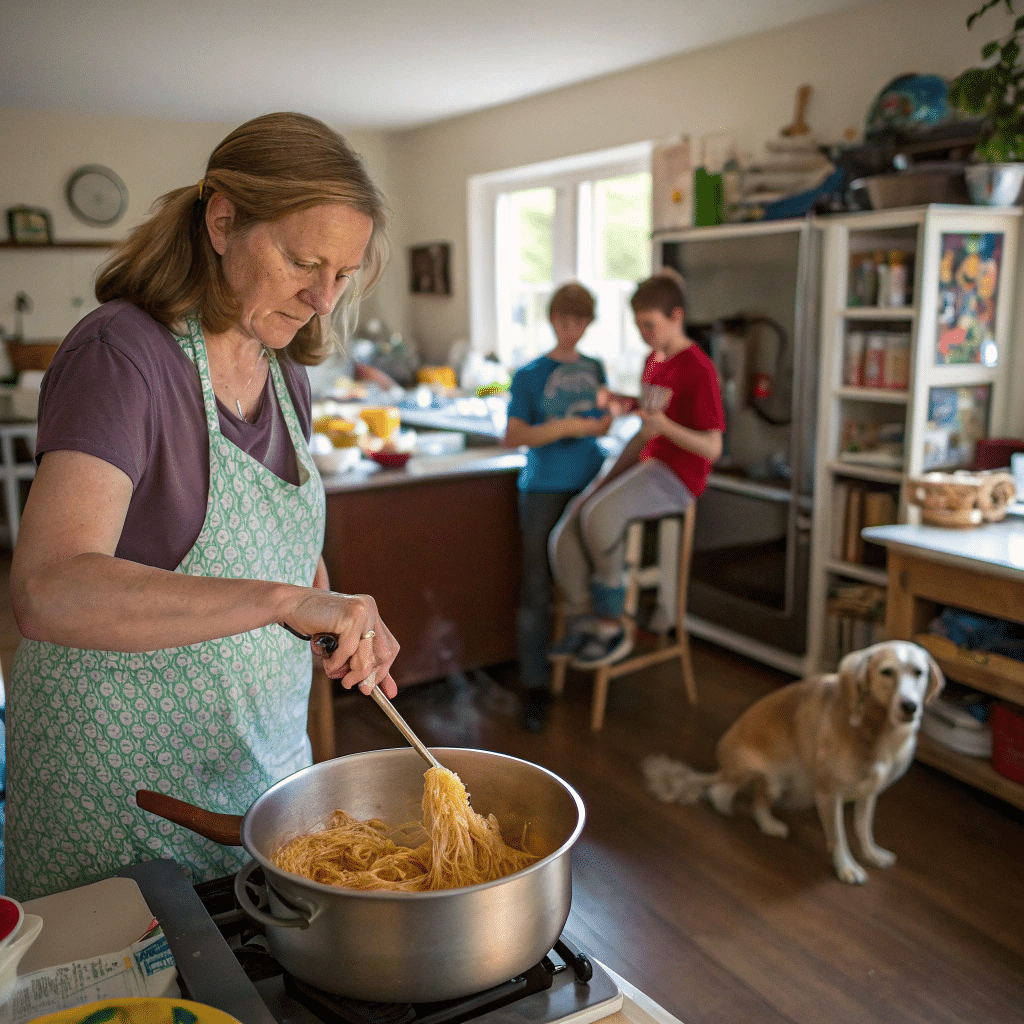
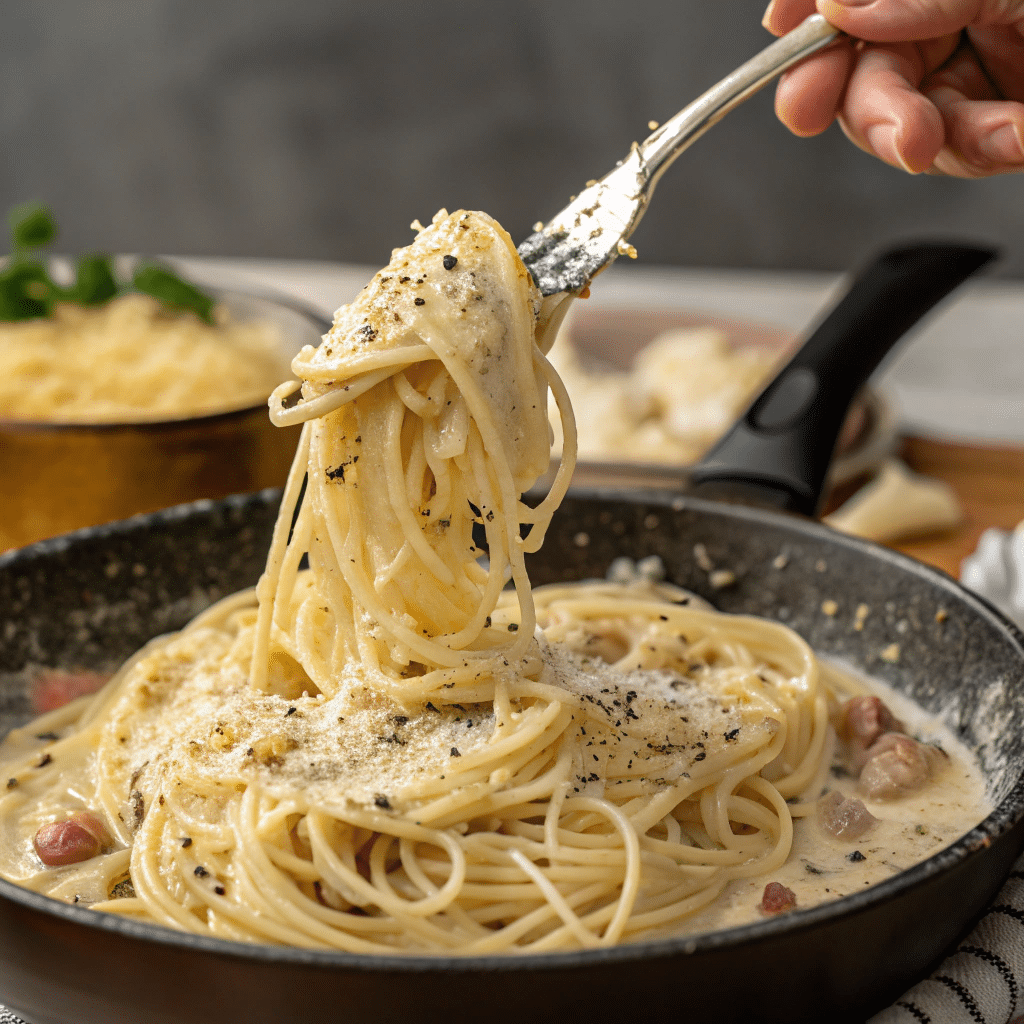
Cacio e Pepe
Ingredients
Equipment
Method
- Bring a large pot of salted water to a boil. Cook the pasta until just al dente.
- While the pasta cooks, toast the freshly ground pepper in a dry pan over medium heat until fragrant, about 1 minute.
- Reserve about 1 cup of pasta water, then drain the pasta.
- Off heat, add pasta to the pan with toasted pepper. Sprinkle in the cheese gradually, tossing vigorously and adding reserved water as needed to create a creamy sauce.
- Toss until the cheese melts and coats the pasta. Serve immediately with extra pepper and Pecorino on top.
Notes
The 7 Italian Pasta Recipes That Changed My Kitchen
These dishes aren’t fancy. They’re not fussy. But they are packed with heart and flavor. Here’s what you can expect:
- Cacio e Pepe – just Pecorino, pepper, and pasta water, yet rich and bold.
- Spaghetti Carbonara – the Roman classic with eggs, cheese, and pancetta.
- Pasta al Limone – creamy, bright, and surprisingly simple.
- Tagliatelle al Ragù (Bolognese) – a slow-simmered hug in a bowl.
- Pesto alla Genovese – basil, garlic, pine nuts, all fresh and raw.
- Amatriciana – spicy, tangy, with tomatoes and guanciale.
- Orecchiette with Broccoli Rabe – a Southern dish with bitter greens and anchovy heat.
Each one has taught me something. Each one is easy enough for a busy home cook and delicious enough to make again and again. As we go deeper, I’ll show you not just how to make them, but how to make them yours.
And hey, if you’re baking some Italian focaccia or need a dessert like torta caprese, these pasta nights pair well with everything.
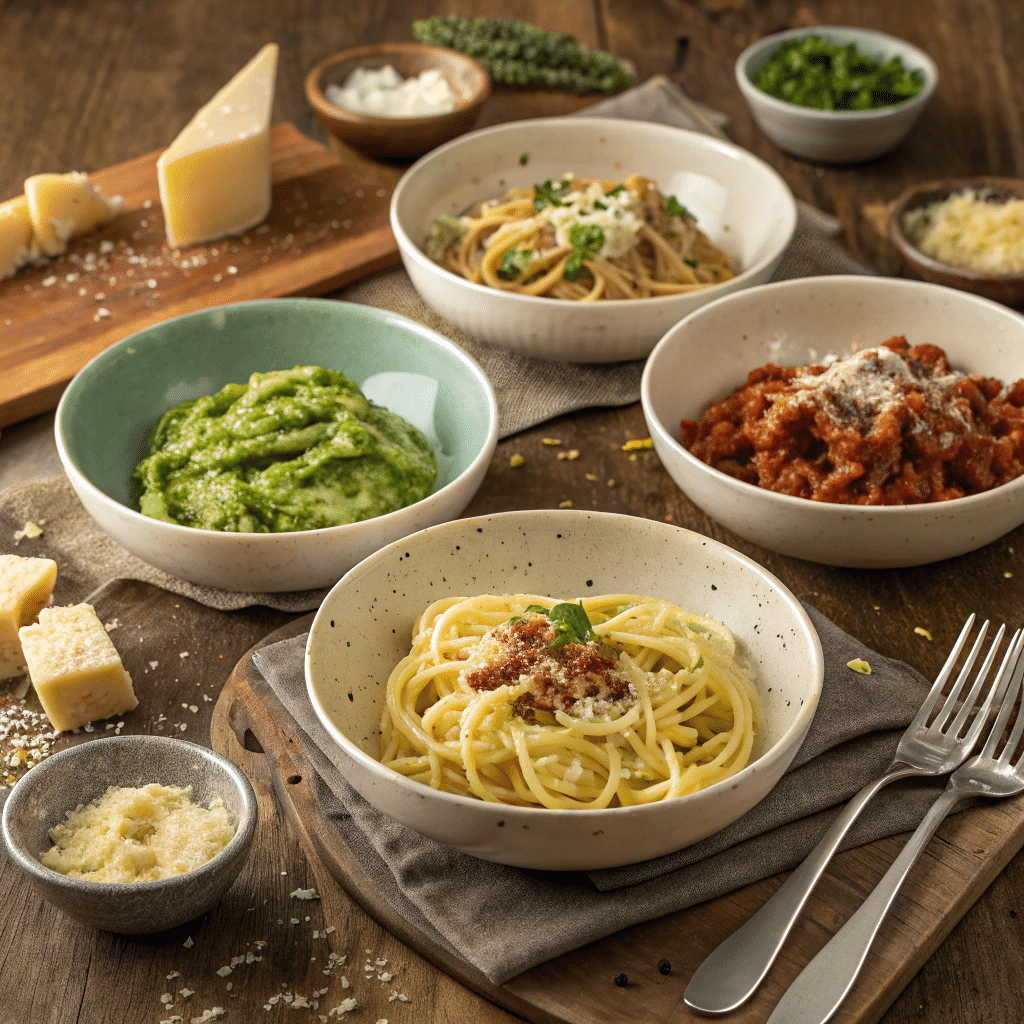
Traditional Italian Pasta-Making Methods
Making Pasta From Scratch: What Nobody Told Me
First time I tried to make pasta dough, I panicked. I didn’t have 00 flour. I didn’t know if my eggs were “large” enough. And kneading? My arms ached after five minutes.
But then I just… kept going.
Turns out, making pasta isn’t about precision. It’s about feel. I used plain flour, cracked two eggs into a flour mound, and started mixing. The dough felt wrong at first. Sticky. Then too dry. But the more I worked it, the more it started to behave. After ten minutes, I had something soft, smooth, and weirdly alive.
That’s the thing about Italian pasta recipes they’re forgiving. They don’t need you to be perfect. You just need to show up with a little flour, a little time, and a lot of heart. Roll it out. Cut what you can. Fettuccine, ravioli, hand-torn scraps. They all taste like effort and that’s what matters.

Boiling Pasta the Right Way (Yes, There’s a Right Way)
I used to toss pasta in water and hope. No salt. No stirring. Often forgotten until the timer screamed. The result? Mush or undercooked noodles that stuck to the strainer.
Then I watched an Italian grandma do it big pot, rolling boil, a handful of salt so bold it made me nervous. “It must taste like the sea,” she said. I never forgot that.
Now I stir early, stir again halfway. And I never drain without saving a mug of the pasta water. That starchy liquid? It’s the secret behind so many Italian pasta recipes. It helps your sauce hug the noodles, not sit beside them.
One more thing I learned the hard way don’t rinse your pasta. Ever. You’re washing away the good stuff. Just drain, toss it into the sauce, and stir with confidence. That last minute of cooking together brings it all home.
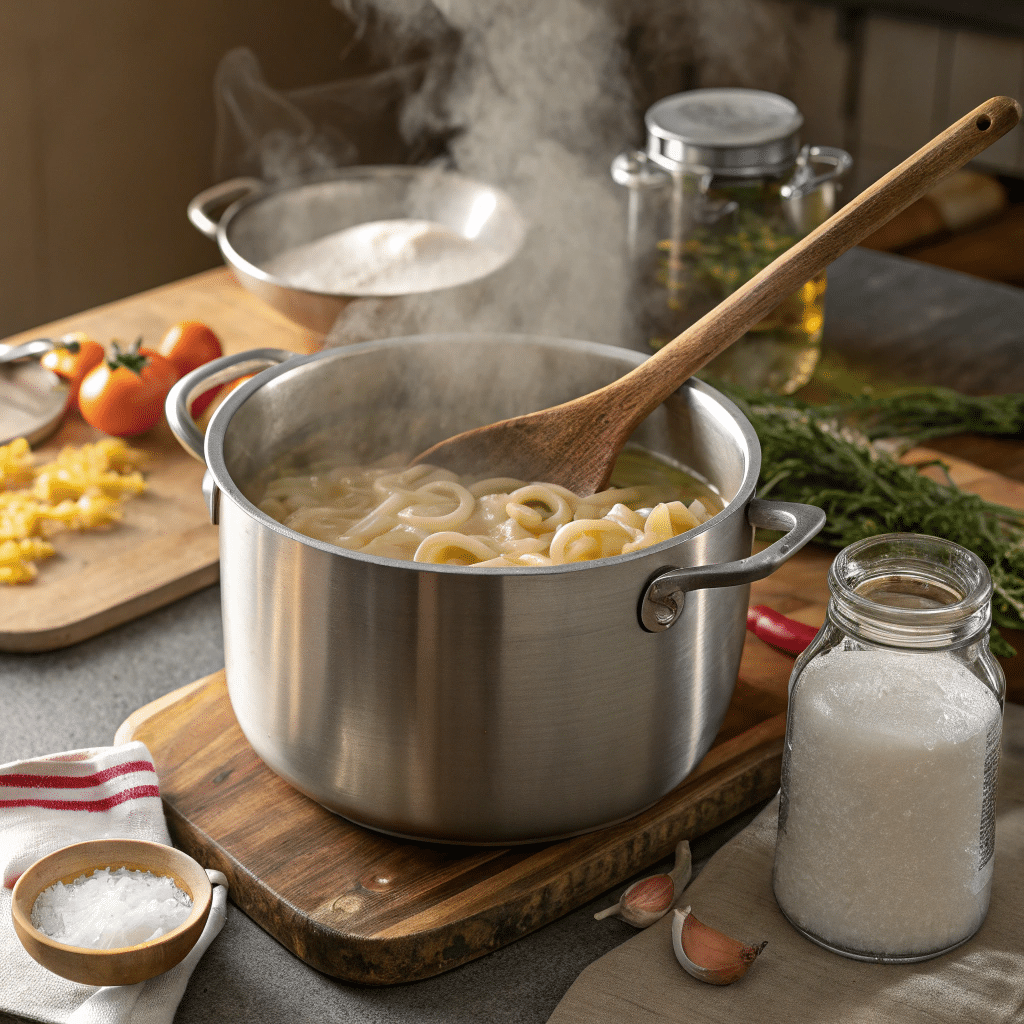
The Four Essential Italian Pasta Sauces
The First One I Mastered: Cacio e Pepe
You wouldn’t think three ingredients could teach you so much. But that’s what cacio e pepe did for me. It’s just Pecorino Romano, black pepper, and pasta water but when done right, it’s hypnotic. I failed it at least five times. The cheese clumped. The sauce broke. It was… sad.
Then one night, I let the grated cheese come to room temp. Used finely cracked pepper. Stirred with a splash of water like I was coaxing silk. That’s when it clicked.
This sauce isn’t heavy. It doesn’t coat like cream. It clings softly, perfectly. It’s the quiet confidence of Roman cooking. And now, it’s one of the Italian pasta recipes I trust when I need comfort fast.

Carbonara: Not Creamy. Not Sorry.
Let’s clear this up real carbonara has no cream. None. Just eggs, cheese (Pecorino or Parm), pancetta (or guanciale, if you can find it), and black pepper. That’s all. And when those ingredients come together the right way, it’s the stuff of dreams.
I used to scramble the eggs literally. Too much heat, not enough timing. The fix? Toss the hot pasta off the heat, mix quickly, and stir like your life depends on it.
Once you get it, this becomes your weeknight hero. Every bite feels rich but clean, not greasy. It’s one of those Italian pasta recipes that surprises people. They think it took forever. It didn’t. It just took love.
You can pair it with a slab of Italian focaccia or serve it solo. Either way, it earns applause.
Pesto alla Genovese: Raw, Fast, Fresh
The smell of fresh basil crushed with garlic still stops me mid-step. Add pine nuts, a good Parmesan, and olive oil that’s pesto alla Genovese. Bright. Raw. Uncooked. It’s not just a sauce, it’s a rush of summer in a bowl.
When you’re using pesto, don’t overheat it. Toss it with pasta off the heat, and add a bit of that magic pasta water. It becomes creamy on its own. You can even spoon it onto toast, swirl it through soup, or dollop it onto grilled veg.
It’s probably the most versatile of all the Italian pasta recipes and easily the fastest.
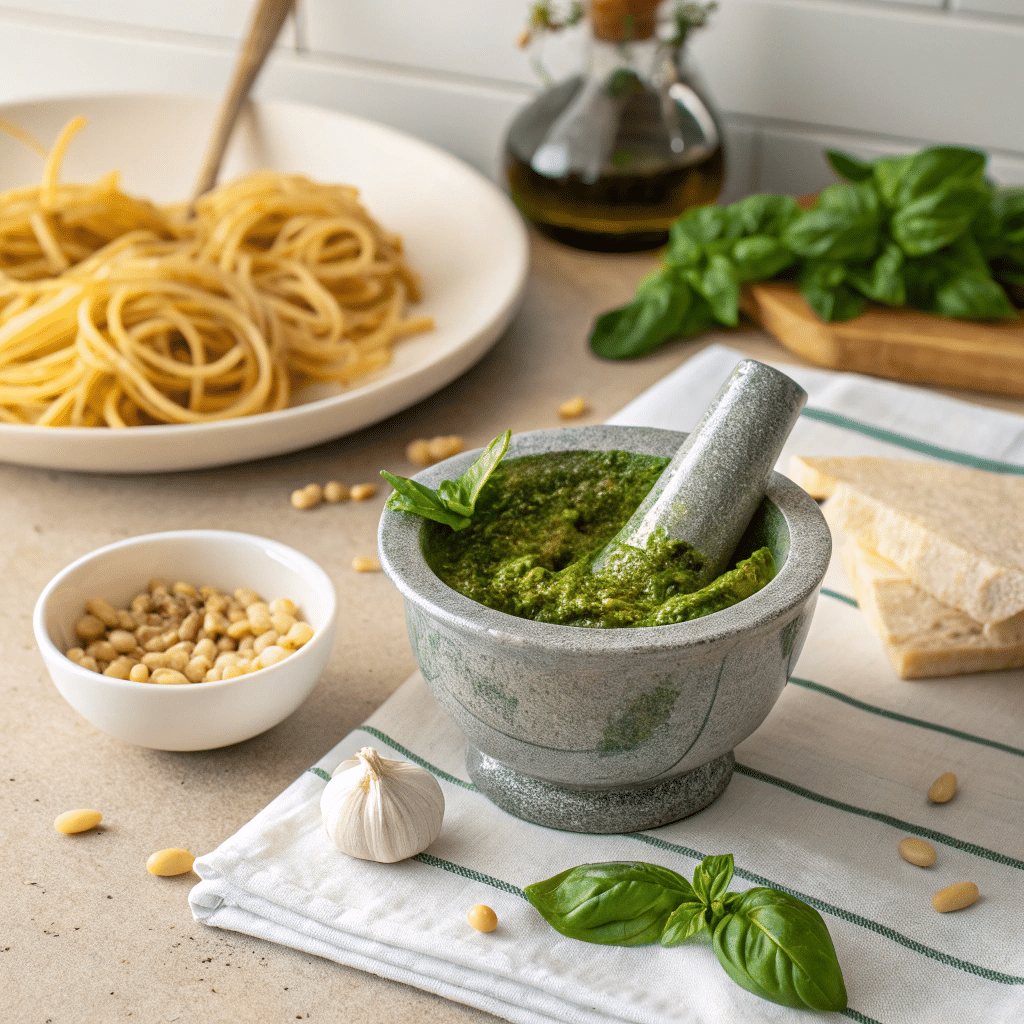
Amatriciana: Heat, Smoke, and Soul
If you haven’t had amatriciana, imagine tomato sauce with backbone. It’s spicy, a little smoky, and full of personality. Made with guanciale (or bacon in a pinch), San Marzano tomatoes, a hint of chili flakes, and always Pecorino.
The first time I tasted it in Rome, I didn’t speak. Just chewed. Slowly. Thought about my life choices.
This sauce is bold. And yet, it still feels like home. You can make a double batch and freeze it. Or use leftovers for a sandwich spread don’t judge, I’ve done it.
Some Italian pasta recipes are quiet. Amatriciana is not. It’s the one that sings.
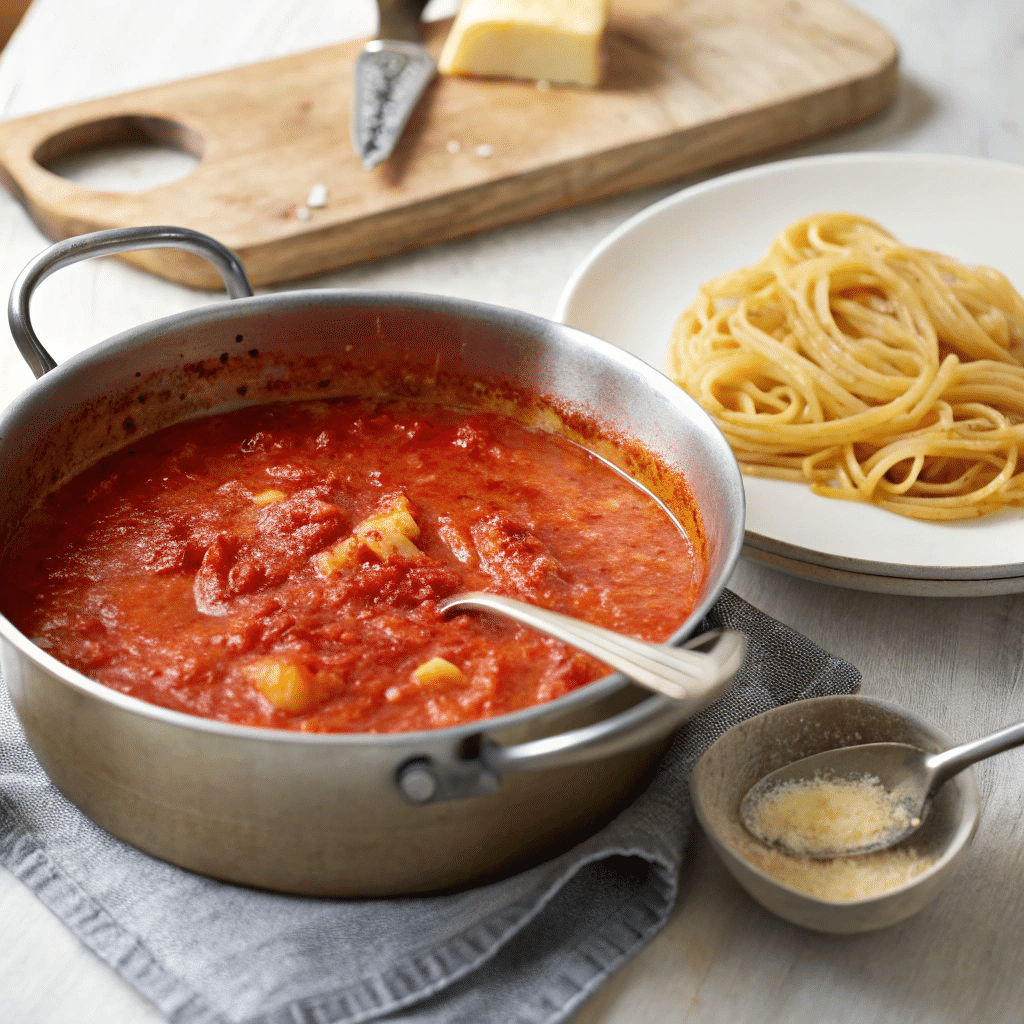
3 More Italian Pasta Recipes You’ll Want to Make Again
Pasta al Limone – Creamy, Sharp, and Fast
This one’s become a weird little favorite in my house. Pasta al limone sounds like it takes effort, but honestly? It’s done before you realize you’re hungry. You melt some butter, grate lemon zest, toss in the pasta water and Parmigiano and it’s done. That’s it.
There’s no cream, but it tastes like there is. The lemon makes everything feel lighter, kind of fresh, like spring. I use linguine, but honestly, whatever’s in the pantry works. It’s one of those Italian pasta recipes that feels fancy but takes ten minutes. Which, frankly, makes me love it more.
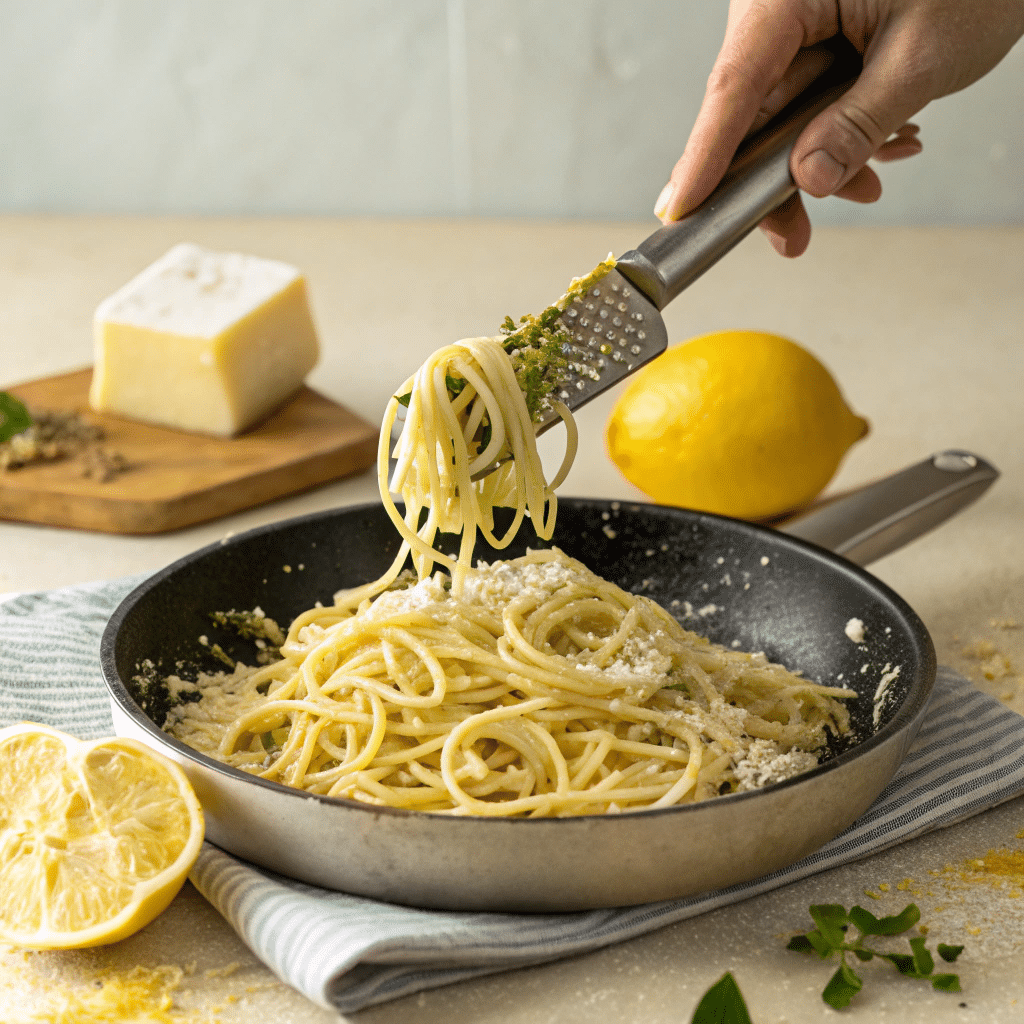
Tagliatelle al Ragù – Slow Food That Feels Like a Hug
This one took me years to get right. Real ragù isn’t fast. It’s not just “meat sauce.” It’s carrots, onion, celery, beef, pork, maybe a bit of milk, a splash of wine, and patience. A big pot. Low heat. Stirring when you remember. Tasting when the house smells too good not to.
It simmers down to something thick and brown no watery sauce here. When you ladle it over tagliatelle, something just clicks. It’s cozy. Like a long nap under a heavy blanket. The kind of pasta that makes silence at the table.
This is why I cook. These kinds of Italian pasta recipes slow, rich, grounding they’re more than food.
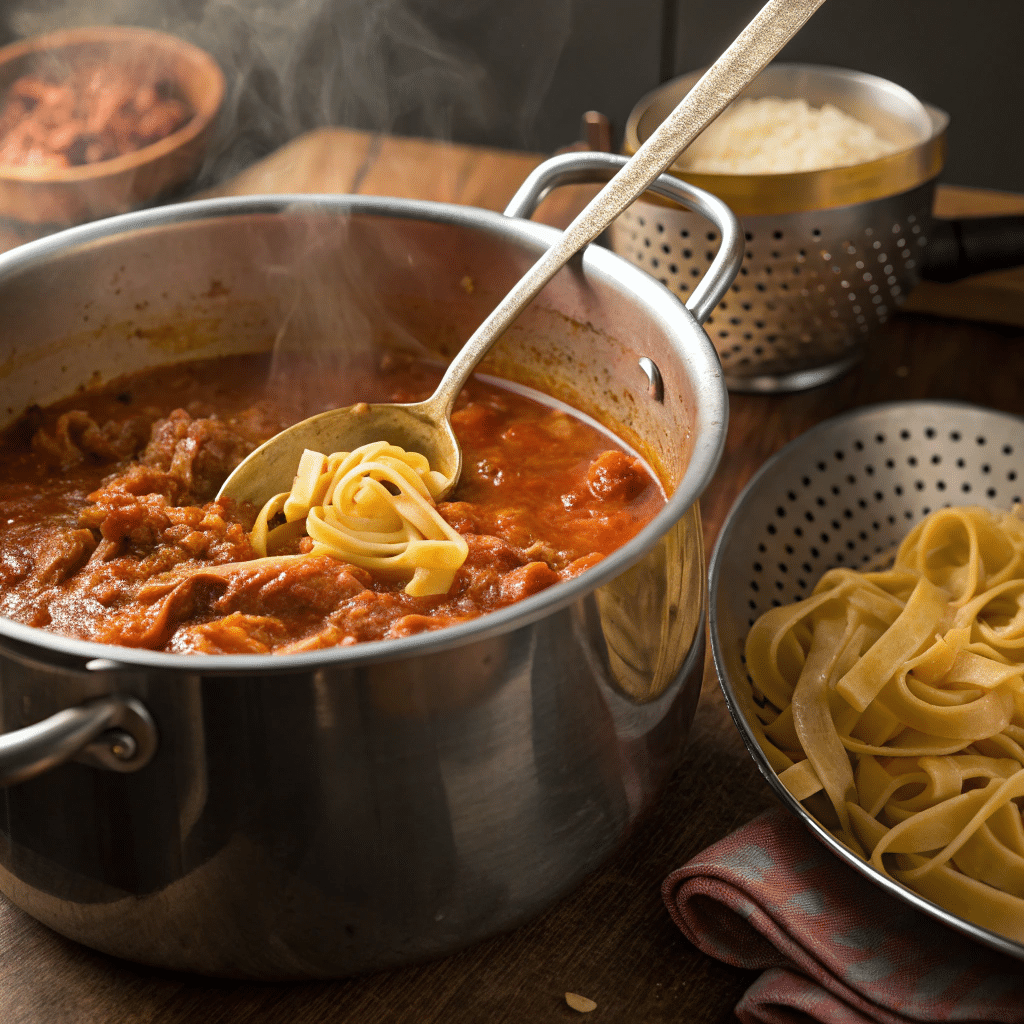
Orecchiette with Broccoli Rabe – Bitter, Bold, and Honest
Okay, this one’s not sweet or mild. It’s bitter. Peppery. Maybe even a little intense. But in the best way. Broccoli rabe is strong stuff, and when it’s tossed with garlic, anchovies, chili flakes, and orecchiette, it turns into something earthy and brave.
The anchovy part? Don’t panic. You melt it into the oil. You don’t taste “fish.” You taste depth. Like something’s been simmering forever, even though you cooked it in 15 minutes.
This one’s not for picky eaters. But if you want an Italian pasta recipe that wakes up your taste buds and makes you feel like you’ve cooked something real this is it.
FAQ – What I Figured Out Along the Way
What is the traditional way to make Italian pasta?
No machines. No shortcuts. Just flour and eggs. You make a little well, crack in your eggs, and mix. It feels awkward at first. Sticky, messy. Then it comes together. That’s how it’s been done forever in most regions. If you go south, you’ll find semolina with water instead—firmer, springier. Both work. What matters more? Taking your time.
How do Italians cook pasta properly?
They don’t wing it like I used to. Big pot. Salted water—salty enough to notice. Let it boil properly before adding anything. Stir. Don’t forget it. Cook it to that bite—not mush. Then save some of the water before draining. That bit of starchy liquid? It’s gold. Helps the sauce actually stick. Nearly every Italian pasta recipe I’ve made works better when I do that.
How to make Italian pasta sauce from scratch?
It’s not as complicated as the jars make it seem. Start with oil and garlic. Tomatoes. Salt. That alone? Already good. Want to get fancier? Toss in herbs, maybe some chili. If I’ve got time, I’ll build a ragù. If not, I’ll make cacio e pepe with just cheese and pepper. Most Italian pasta recipes aren’t built on how much you use—but how well you treat it.
What are the 4 classic Italian pasta sauces?
The ones I learned—and actually use:
– Carbonara (no cream, just egg and cheese)
– Cacio e pepe (simple, sharp, peppery)
– Amatriciana (a bit spicy, deep flavor)
– Pesto (fresh, raw, fast)
Each one taught me something different. And once you’ve got them down, you can improvise like it’s second nature.
Why do Italians add pasta water to the sauce?
Because it works. That cloudy water has starch—it pulls everything together. Makes the sauce cling instead of sit in a puddle. I used to skip it. Big mistake. Now I do it without thinking. Just a splash can change everything. Most great Italian pasta recipes use that trick, even if they don’t spell it out.
Conclusion – What I Didn’t Expect to Learn from Pasta
I didn’t start cooking to master anything. I just wanted dinner on the table. Fast, hopefully edible, maybe even something the kids wouldn’t complain about. But these recipes? These seven Italian pasta recipes? They changed things.
Not overnight. Not dramatically. But slowly, in ways that snuck up on me. I stopped rushing. I started noticing the smell of garlic hitting hot oil. The way pasta water turns cloudy at just the right moment. The quiet that happens when people are eating something that feels like care.
Cooking this way made me feel more at home in my own kitchen. Like I wasn’t just throwing things together, but building something small and real. That’s what these meals became moments that stuck.
So if you’re still figuring it out, burning the noodles, getting the sauce too thin keep going. That’s how it starts. That’s how it started for me.
